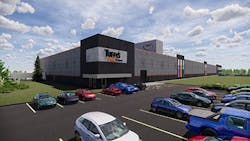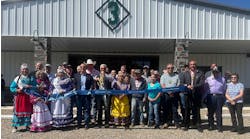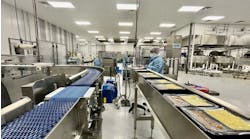Until last month’s coronavirus pandemic, the food and beverage industry appeared willing to say yes to more capital projects in 2020.
Our look at the budgets of 31 of the biggest publicly traded, U.S.- and Canadian-based food and beverage processing companies indicates they were hanging back a little last year, but are slightly more inclined to move forward this year. In 2019, they spent $15.7 billion on capital projects, which was 6% less than they had budgeted; for 2019, they’re projecting $16.8 billion in capital expenditures, which is 7% more than they spent last year.
But those budgets were written late last year; a lot has changed since then.
Economic growth that has lasted for more than a decade had been prodding decision makers to greenlight projects, say representatives of architectural and engineering firms that specialize in food and beverage. A favorable financial climate with low interest rates added to the always existent pressures to bring new products to market quickly, increase capacity and efficiency and do all the other things that companies build or improve plants to do.
In our 2020 Capital Spending Report, we look at the 31 biggest publicly traded, U.S-. and Canadian-based food and beverage processing companies to see where they're spending their money. See what they're spending and what they're spending it on in this PDF.
“In talking to colleagues in the industry, from equipment providers to site selectors, everybody seems to be very optimistic on 2020,” says Jason Robertson, market director for food and beverage at CRB. “It used to be an election year was a goofy time to do something, but I haven’t seen that so far this year.”
Harlan VandeZandschulp, president of Gleeson Constructors & Engineers LLC, agrees that it’s an encouraging time for big projects. “I think low interest rates are helping the building [decisions],” he says. “If they can’t afford to build it now, they’ll never build it.”
But that was before the coronavirus upended the global economy. Now the industry has to take the short- and long-term effects of the crisis into account – while the long-term impact of the virus is still unclear.
The immediate impact on construction projects appears to be very much localized. Some cities, like Boston, or entire states like New York and Pennsylvania, are calling a halt to most construction projects; other states, like Ohio, were allowing them to continue as of press time.
The long-term effect is harder to predict. The crisis has meant a surge in demand on the retail side for the industry as a whole. Retail packaged food sales will grow up to 30% through May, according to an estimate by Credit Suisse. Food processors will have to work out not only how to meet the immediate demand but how and to what extent the changes will last.
The need for speed
Before the virus crisis, food & beverage companies wanted their new or revamped plants to get on line as quickly as possible to feed the product pipeline, says Brandon Davis, vice president and general manager for Eastern and Mexico Operations at The Austin Co.
“For many food and beverage plant owners, there is a constant struggle between cost and schedule. The food and beverage business is tight and competitive, so the costs have to be carefully managed,” Davis says. “However, in recent years, speed has a slight edge on cost. Many plant owners are working to meet market demands with plant networks operating at capacity, trying to bring new products to market to capture market share or be first to market. These conditions drive the need for an accelerated schedule.”
Pet Food Plant Leaves Room to Grow
The makers of Tuffy’s Pet Foods are shelling out $65 million for a new plant that they can ... shell out.
The new facility, in Delano, Minn., will process treats and other pet food when it comes on line this fall. One of the priorities was to give the plant a big enough footprint to make sure that there would be enough room to grow.
“We shelled that out, so we plan to grow beyond what we’re building the building to do today,” says Mark Sailer, engineering director for KLN Family Brands, Tuffy’s parent.
Tuffy’s makes dry and moist pet food, for both private label and its own NutriSource and other brands. The new plant, being built by CRB, will have two extrusion lines to process semi-moist treats, with the capability to co-extrude hard-shell treats with soft centers.
Any new lines will have the potential to apply technologies that Tuffy’s doesn’t use now, like dehydrating and freeze-drying, but no decisions have been made on how to use this future space, says Brian Garlick, KLN’s general manager.
“We’ve left some white space for growth, so we’re in the phase right now of trying to determine what else we’re going to put in that space,” Garlick says.
The Delano plant addresses other issues that often arise in planning a new facility. One is labor availability. The new plant will replace one in Perham, Minn., which is KLN’s headquarters but is in a relatively rural part of western Minnesota with not much available labor. Delano is about 20 miles from the Twin Cities, greatly deepening the labor pool.
Food safety was an uppermost consideration, which helped direct the plant’s layout. The extrusion is the kill step, and the plant is designed to keep the pre-kill and post-kill areas separate, with different entrances and break rooms for each side.
Materials for floors, walls, piping and other structural aspects were chosen with sanitation in mind, Garlick says: “Everything’s designed so it can easily be cleaned and really reduce any risk of any contamination.”
A look at our table of leading projects, which you can download here, bears that out. Several of them will turn out products that are especially in demand now. Not only do the two biggest projects involve protein, but they both belong to Maple Leaf Foods, one making animal protein and the other plant-based products. No. 4 on the list is a hard seltzer facility in Glendale, Ariz., for Mark Anthony Brewing, creator of the wildly popular White Claw Hard Seltzer. In addition, several facilities are being built for pet food, an increasingly competitive and lucrative category that has carried big players like General Mills and J.M. Smucker to profitability in recent quarters.
Juggling production
Speed to market isn’t always about new products. Sometimes it’s about increasing supply of an existing one, or just producing it more efficiently. That can be a special challenge, especially if the processor needs to maintain production while the project is under way, says Tyler Cundiff, vice president of business development, food & beverage at Gray.
“At Gray, we always put the necessary safeguards in place such as temporary walls, accommodation of existing production schedules, among other items to certify food safety is met,” Cundiff says. “For example, we recently completed the state-of-the-art meat processing and packaging facility for Kraft Heinz in Iowa. The plant manager was impressed that the slicing line was operating in one room, and in the next room, which was separated by IMP [insulated metal panel] walls, construction was still happening without product contamination.”
Arguably the first fundamental decision in a capital project is whether to build from the ground up, buy and adapt someone else’s facility, or expand an existing one. The latter options are more likely for new products, since many processors are reluctant to make a huge bet on something yet unproven.
“You generally don’t see a greenfield site for a new product,” CRB’s Robertson says. “Many of the big guys are going to try to figure out ‘Can you strip out this line to bring a new product to market?’ ”
Jeff Counsell, co-founder and managing broker of Global Food Properties, a real estate firm specializing in food production facilities, says buying an existing building is usually cheaper – but not always.
“Converting or expanding existing facilities can yield an advantage in speed-to-market: The building is up, the utilities and entitlements are in place, labor may be pre-existing and the zoning and regulatory framework likely align with the intended use,” Counsell says. “Common thinking is that also is less expensive, though we have heard many a client say new construction, of the perfect building in the perfect location, would not have cost much more.”
Finding labor
One of the biggest ongoing concerns across the food industry is labor availability. “Employee availability is becoming a really big deal,” Robertson says. “Twenty, 30 years ago, [a food plant] might have been the only opportunity to work in certain communities across the country. Now some people have options and perhaps even better working conditions.”
The labor situation affects building projects in several ways. The first and most basic is site selection. Many food plants are located in sparsely populated rural areas because it’s closer to supplies, land is cheaper and there are fewer neighbors to be affected by air or water discharges. But in many such areas, the labor pool is shallow.
“We often complete studies to look at where capacity should be added, where new plants could be built or where expansions should occur,” says Davis of Austin Co. “Many factors are considered in these analysis efforts, but labor availability and labor costs have become significant considerations in recent years given the tightening labor market.”
Davis adds that low labor availability affects construction crews too, which Austin compensates for through recruitment, advanced work coordination and worksite automation.
Automation in many cases is an answer to the labor problem for processors also. Plants should be designed to accommodate it, in both its current and future forms.
“Automation drives throughput, and throughput is the antidote to thin margins,” Counsell says. “The property consequences of automation typically dictate building design.” Desirable features include 26-ft. ceiling clearances for equipment, mezzanines and superstructures; a linear configuration with line-of-sight production whenever possible and a building footprint that can accommodate up to a doubling in size.
“I think for many years, clients were sitting on a lot of cash as a company. It was about making Wall Street happy,” Robertson says. “I think how if you’re going to continue to grow the company, to grow your stock price if you’re publicly traded, you’re left with having to make some tough decisions on ‘hey, it’s time.’ ”





